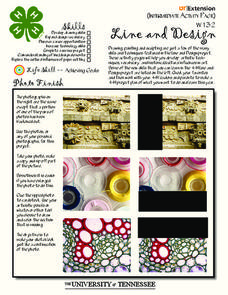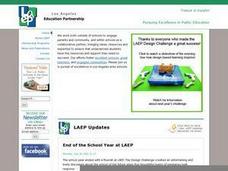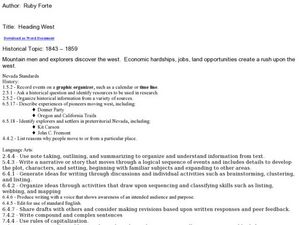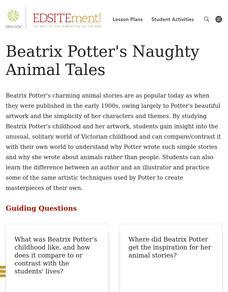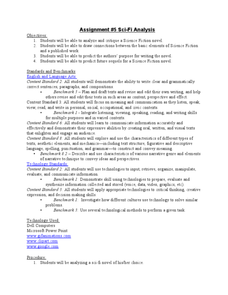Curated OER
Georgia O'Keeffe Watercolor
Students demonstrate three different watercolor techniques using flower pictures and flowers as the inspiration. They work with organic shapes.
Curated OER
Creating Comic Strips
Students create comic strips to communicate ideas that cannot be expressed through words alone.
Curated OER
Abstractions/Gestures
Students examine and display the differences between literal, and non-literal movement and abstraction using a creative project in movement. This project originates as an individual item, culminating in a small group performance.
Curated OER
Line and Design
With photography as the focus, students learn about line and design. Learners take pictures, and use the photos as a means to analyze artistic elements.
Curated OER
Digital Dada
Students explore the concept of photomontage the juxtaposition of photo images and fragments of images to create new images and meanings. To research Hannah Hoch and the Dadists who created them. To incorporate digital technology in the...
Curated OER
Architecture: Homes All Around
Students listen to a book, "This is My House" and sing a song to the tune of Home on the Range. They use the internet to view examples of Frank Lloyd Wright's architecture. Students take pictures of architectural details of their homes...
Curated OER
Sense of Place
Young scholars identify the major folk regions of Louisiana and the relationship between folklife, geography, and ecology. They give deeper thought to what makes their own community unique, what their sense of place actually is. ...
Curated OER
Sim's Cities
Young scholars investigate city management and government by creating a fictional city in groups. In this civics instructional activity, students create rules and a mascot for their fictitious city which they create from poster board...
Curated OER
Giving Voice to History
Students examine the plight of Japanese Americans during World War II. In this World War II lesson, students participate in a mock evocation simulation, research primary and secondary documents about internment camps, and share their...
Pennsylvania Department of Education
Analyzing Literary Elements in Fiction
Students analyze the characters and events in fictional writing. In this literary elements lesson, students study the meaning of the words characterization and fiction. They listen to the story Pigsty by Mark Teague, or any other book...
Curated OER
Analyzing Logos
Students analyze common logos they see daily and describe what the logos bring to mind. They redesign a company logo incorporating the company's philosophy into their sketches. Students present their findings and redesign to the class.
Curated OER
Wire Circus
Second graders examine the life and work of Alexander Calder. They create a wire sculpture on a cirucs theme of their choice. They work on these projects in groups. They utilize telephone wire, or any thin wire cut to manageable lengths.
Curated OER
Walter Cronkite: Witness to History
Students brainstorm a list of news sources. They interview people about today's media and discuss their results. After watching segments of a film about Walter Cronkite, they role play as reporters and subjects from an historic period...
Curated OER
Read That Label!
Students explore reading nutritional labels and making good food choices through simulation. They prepare and design a label for a product. In addition, they create packaging and advertising to ensure access to the population.
National First Ladies' Library
We're off to see the Wizard!
Students explore the process of play and movie making from books. They study the basic elements of drama and write and produce a play based on a chosen theme. Students explain the basic elements of a play by looking at "The Wonderful...
Curated OER
Heading West
Young scholars study the concept of the westward expansion. For this exploration of the western U.S. lesson, students participate in different activities that explain economic hardships, jobs, and land opportunities. Young scholars...
Curated OER
What is Framing?
Middle schoolers practice framing issues. In this writing skills lesson, students participate in a classroom activity that requires them to look at specific topical issues by framing them. Middle schoolers then create collages on current...
Curated OER
Edward Lear, Limericks, and Nonsense: There Once Was...
Young scholars recognize poetic devices including rhyme, syllabification, and meter. They identify the characteristics of a nonsense poem and of a limerick. They write their own limericks.
Curated OER
Beatrix Potter's Naughty Animal Tales
Students gain insight into the unusual, solitary world of Beatrix Potter's Victorian childhood and can compare/contrast it with their own world to explain why Potter wrote such simple stories and why she wrote about animals rather than...
Curated OER
Create Your Own Ad
Students examine the elements of advertising. They analyze the format and structure of advertisements. They develop awareness of advertising techniques and explain that media messages and products are composed of a series of separate...
Curated OER
Edward Lear, Limericks, and Nonsense: There Once Was?
Students explore limericks. In this poetry writing lesson, students listen to and read a variety of poems written by Edward Lear. Students count syllables and identify meter by clapping as they read aloud. Students complete a limerick...
Curated OER
Huguenot Street
Third graders visit Early Huguenot Street and identify architectural structural and design elements that were in use before 1720. They consider how architecture has evolved and complete Venn diagrams with their observations.
Curated OER
Assignment #5 Sci-Fi Analysis
Class members select a science fiction novel for independent study. To verify they have completed the reading, they write a summary, a critique, and an outline of the plot for a sequel or prequel. They then deliver a five-minute speech,...
Curated OER
Seeing through Touch
Students explore solid objects using touch. In this art lesson, students are blindfolded and given a 3 dimensional object to explore with their hands. After the object is removed, students draw what they think the object looked like....





